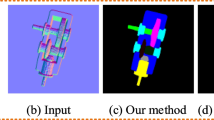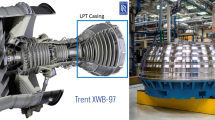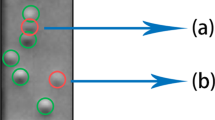Abstract
In the milling process, the wear area of the tool is often segmented using the traditional image processing method to quantify the tool wear value. However, these methods have the disadvantages of having weak anti-noise capabilities and low segmentation accuracy. Although the semantic segmentation network can achieve excellent segmentation accuracy, obtaining enough end mill wear images to support the semantic segmentation network’s training is challenging due to the high acquisition cost of wear images. As a result, this paper suggests a small sample end mill wear area segmentation method based on transfer learning and generative adversarial networks to address the issue of insufficient samples of end mill wear images. In this paper, WGAN is used to generate wear images to expand the dataset with a few samples, and the transfer learning method is used to improve the generalization ability of the segmentation network and finally achieve small sample training. This approach increases mPA by 4.46% and mIOU by 8.97% when compared to merely using the semantic segmentation network for small sample training. According to experimental findings, this method not only has high stability and segmentation accuracy but also solves the problem of insufficient end mill wear image samples. The method proposed in this paper can be effectively applied to the intelligent detection of the tool wear state, improving the accuracy and stability of the measurement of the tool wear value.
















Similar content being viewed by others
References
Teti R, Jemielniak K, O Donnell G, Dornfeld D (2010) Advanced monitoring of machining operations. CIRP annals 59:717–739
Yang M (1996) Crater wear measurement using computer vision and automatic focusing. J Mater Process Tech 58:362–367
Yu H, Wang K, Zhang R, Wu X, Tong Y, Wang R, He D (2021) An improved tool wear monitoring method using local image and fractal dimension of workpiece. Math Probl Eng 2021:1–11. https://doi.org/10.1155/2021/9913581
He Z, Shi T, Xuan J, Li T (2021) Research on tool wear prediction based on temperature signals and deep learning. Wear 478–479:203902. https://doi.org/10.1016/j.wear.2021.203902
Huang Z, Zhu J, Lei J, Li X, Tian F (2021) Tool wear monitoring with vibration signals based on short-time fourier transform and deep convolutional neural network in milling. Math Probl Eng 2021:1–14. https://doi.org/10.1155/2021/9976939
Yu J, Cheng X, Lu L, Wu B (2021) A machine vision method for measurement of machining tool wear. Measurement 182:109683. https://doi.org/10.1016/j.measurement.2021.109683
Li L, An Q (2016) An in-depth study of tool wear monitoring technique based on image segmentation and texture analysis. Measurement 79:44–52. https://doi.org/10.1016/j.measurement.2015.10.029
Zhu K, Yu X (2017) The monitoring of micro milling tool wear conditions by wear area estimation. Mech Syst Signal Pr 93:80–91. https://doi.org/10.1016/j.ymssp.2017.02.004
Bergs T, Holst C, Gupta P, Augspurger T (2020) Digital image processing with deep learning for automated cutting tool wear detection. Procedia Manuf 48:947–958. https://doi.org/10.1016/j.promfg.2020.05.134
Miao H, Zhao Z, Sun C, Li B, Yan R (2021) A u-net-based approach for tool wear area detection and identification. Ieee T Instrum Meas 70:1–10. https://doi.org/10.1109/TIM.2020.3033457
Xia L, Shi Y, Lin H, Zheng H, Cao X, Chen B, Zhou Y, Sun W (2022) Segmentation and quantitative evaluation for tool wear condition via an improved se-u-net. Int J Adv Manuf Technol. https://doi.org/10.1007/s00170-022-09338-2
Goodfellow IJ, Pouget-Abadie J, Mirza M, Xu B, Warde-Farley D, Ozair S, Courville A, Bengio Y (2014) Generative adversarial nets. MIT Press
Jiang C, Mao Y, Chai Y, Yu M (2021) Day-ahead renewable scenario forecasts based on generative adversarial networks. Int J Energ Res 45:7572–7587. https://doi.org/10.1002/er.6340
Arjovsky M, Bottou L (2017) Towards principled methods for training generative adversarial networks. arXiv e-prints https://doi.org/10.48550/arXiv.1701.04862
Xiao Y, Wu J, Lin Z (2021) Cancer diagnosis using generative adversarial networks based on deep learning from imbalanced data. Comput Biol Med 135:104540. https://doi.org/10.1016/j.compbiomed.2021.104540
Zhang X, Yu L, Yin H, Lai KK (2022) Integrating data augmentation and hybrid feature selection for small sample credit risk assessment with high dimensionality. Comput Oper Res 146:105937. https://doi.org/10.1016/j.cor.2022.105937
Arjovsky M, Chintala S, Bottou L (2017) Wasserstein generative adversarial networks. JMLR.org https://doi.org/10.5555/3305381.3305404
Ronneberger O, Fischer P, Brox T (2015) U-net convolutional networks for biomedical image segmentation. arXiv e-prints https://doi.org/10.48550/arXiv.1505.04597
Simonyan K, Zisserman A (2014) Very deep convolutional networks for large-scale image recognition. arXiv e-prints https://doi.org/10.48550/arXiv.1409.1556
Kamilaris A, Prenafeta-Boldú FX (2018) A review of the use of convolutional neural networks in agriculture. J Agric Sci 156:312–322. https://doi.org/10.1017/S0021859618000436
Li Y, Mou W, Li J, Liu C, Gao J (2021) An automatic and accurate method for tool wear inspection using grayscale image probability algorithm based on bayesian inference. Robot Cim-Int Manuf 68:102079. https://doi.org/10.1016/j.rcim.2020.102079
Peng R, Liu J, Fu X, Liu C, Zhao L (2021) Application of machine vision method in tool wear monitoring. Int J Adv Manuf Technol 116:1357–1372. https://doi.org/10.1007/s00170-021-07522-4
Funding
This research was supported by the National Natural Science Foundation of China (No. U21A20134) and the Key Research and Development Program of Zhejiang Province (No. 2021C01148).
Author information
Authors and Affiliations
Contributions
Chang Chen and Chen Lin contributed to the study conception and design. Material preparation, data collection, and analysis were performed by Chen Lin and Zuji Li. The experimental design and implementation were completed by Chen Lin. The first draft of the manuscript was written by Chang Chen and Chen Lin. All authors commented on previous versions of the manuscript. All authors read and approved the final manuscript.
Corresponding author
Ethics declarations
Competing interests
The authors declare no competing interests.
Additional information
Publisher's note
Springer Nature remains neutral with regard to jurisdictional claims in published maps and institutional affiliations.
Rights and permissions
Springer Nature or its licensor (e.g. a society or other partner) holds exclusive rights to this article under a publishing agreement with the author(s) or other rightsholder(s); author self-archiving of the accepted manuscript version of this article is solely governed by the terms of such publishing agreement and applicable law.
About this article
Cite this article
Chen, C., Lin, C., Meng, Z. et al. Semantic segmentation of end mill wear area based on transfer learning with small dataset. Int J Adv Manuf Technol 127, 3599–3609 (2023). https://doi.org/10.1007/s00170-023-11725-2
Received:
Accepted:
Published:
Issue Date:
DOI: https://doi.org/10.1007/s00170-023-11725-2




